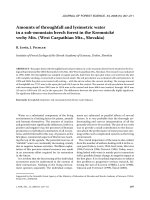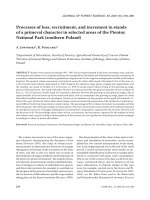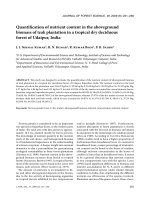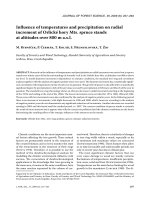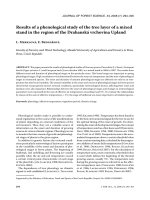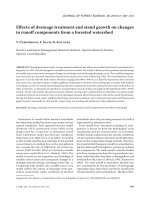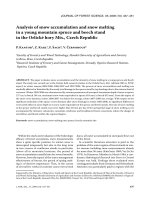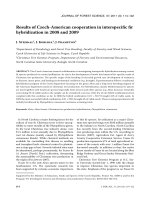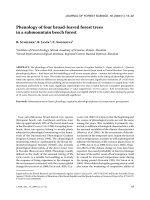Báo cáo lâm nghiệp: "Results of a phenological study of the tree layer of a mixed stand in the region of the Drahanská vrchovina Upland" ppt
Bạn đang xem bản rút gọn của tài liệu. Xem và tải ngay bản đầy đủ của tài liệu tại đây (390.76 KB, 12 trang )
294 J. FOR. SCI., 54, 2008 (7): 294–305
JOURNAL OF FOREST SCIENCE, 54, 2008 (7): 294–305
Phenological studies make it possible to under-
stand regularities in the course of life manifestations
of plants depending on external conditions of the
environment. us, they are a valuable source of
information on the onset and duration of growing
seasons in various climatic regions. Phenology serves
to monitor the time course of growth and phenologi-
cal stages of plants in the given region.
In addition to genetic factors also external condi-
tions particularly meteorological factors participate
in the variability of the onset and duration of phe-
nological stages in forest plants. e beginning of
budbreak, leaf unfolding and flowering are usually
possible when the air and soil temperature exceed
a certain critical point characteristic of each stage
of the plant life cycle (L 1988; B,
K 2002).
The dependence of tree phenology on climatic
signals is well established (L, T
1995; K 1996). Temperature has been found to
be the best environmental signal for the tree to use for
the optimal timing of the onset of growth. For deter-
mining the onset of developmental stages, the concept
of temperature sum has often been used (H,
H 1988; K 1996, 2000; D 1996;
V V et al. 2002). Temperature sum is the accu-
mulated temperature above a certain threshold value
from a certain starting date, calculated by the progres-
sive addition of mean daily temperatures (H
et al. 1986; D 1996; B, K
1999; B, N 2007). For the calculation of
temperature sums, most commonly a threshold value
is used which defines the beginning of the thermal
growing season, usually 5°C. e temperature sum
during the growing season is referred to as the effec-
tive temperature sum (T 1980; H
et al. 1986; L 1994; D 1996;
B, K 1999; B, N 2007).
Supported by the Ministry of Education, Youth and Sports of the Czech Republic, Project No. MSM 6215648902.
Results of a phenological study of the tree layer of a mixed
stand in the region of the Drahanská vrchovina Upland
L. M, E. B
Faculty of Forestry and Wood Technology, Mendel University of Agriculture and Forestry in Brno,
Brno, Czech Republic
ABSTRACT: e paper presents the results of phenological studies of Norway spruce (Picea abies [L.] Karst.), European
beech (Fagus sylvatica L.) and European larch (Larix decidua Mill.) in a mixed stand in 2004 to 2007. e results show
different onset and duration of phenological stages in the particular years. is broad range was important in spring
phenological stages. High correlations were determined between the mean air temperature and the start of phenological
stages in monitored species. e onset and duration of autumn phenological stages are affected not only by air tem-
perature but also by air humidity. e annual variability in the onset and course of phenological stages in forest species
showed that except genetic factors external conditions, particularly meteorological factors, affecting their onset and
duration were also important. Relationships between the onset of phenological stages and changes in meteorological
parameters were expressed by the sum of effective air temperatures exceeding 0 and 5°C. To evaluate the relationships
by means of the sum of effective temperatures > 5°C, the stage of budbreak was most important in all studied species.
Keywords: phenology; effective temperature; vegetation period; climatic change
J. FOR. SCI., 54, 2008 (7): 294–305 295
Temperature sum models may not be equally accu-
rate for all species. Early-flowering species and late-
flowering species can be expected to differ in their
responses, particularly in deciduous forests with
their strong seasonal variation in light intensity. For
spring geophytes direct solar radiation may play an
important role for vegetative and generative devel-
opment (D 1996; M, B
2006).
e course of autumnal phenological stages de-
pends again on the air temperature affecting the syn-
thetic activity of plants. Nutrient and water reserves
and particularly the effect of diurnal photoperiod
(L 1988) are other important factors. Due to
weather the particular stages can be shifted and thus
the further development of plants disturbed.
Depending on changes in weather in the given
climatic conditions according to changes in pheno-
logical stages we can also evaluate trends in climate
changes (K 1996, 2000). Expected climatic
changes and related negative factors can affect the
course of basic living phenomena of plants (K
2000, L 2002; B, K
2002; Š et al. 2006). Due to warm-
ing changes in the development of forest trees and
herbs can also occur. Phenological data are a certain
expression of the climate character of a given region.
us, they can contribute to assess the variability of
weather and also to evaluate the impacts of potential
climatic changes on forest ecosystems (B,
M 2007a). Acquired knowledge could be
used in the habitat change of some species where
their future evolution and reproduction under the
influence of changed climate conditions will be en-
sured (Š 2005).
MATERIAL AND METHODS
Phenological observations of forest trees have
been carried out on a research plot of the Institute
of Forest Ecology, Mendel University of Agriculture
and Forestry (MUAF) in Brno (Rájec – Němčice)
since 1991. e present paper is aimed at the results
of monitoring phenological phenomena of the tree
layer of a young mixed stand in 2004 to 2007.
e research plot locality is situated on the north-
eastern to eastern slope of the watershed ridge at
an altitude of 625 m. e area is characterized by
coordinates 16°41'30''E and 49°26'31''N in the geo-
graphical unit of the Drahanská vrchovina Upland.
Climatically, the region is slightly warm and slightly
humid with the long-term mean of annual tem-
peratures 6.6°C and annual precipitation 683 mm
(K 1992). In the period 1990 to 2006, mean
annual temperature 6.96°C and total precipitation
734 mm were measured. Figs. 3 and 4 characterize
the actual situation of the locality from the aspect of
precipitation and temperature.
e species composition of trees of the 27-year
mixed stand is as follows: Norway spruce (Picea
abies [L.] Karst.) 60%, European beech (Fagus syl-
vatica L.) 30%, European larch (Larix decidua Mill.)
10% and European birch (Betula pendula Roth) as an
interspersed species. e shrub layer of the stand is
represented by Sambucus racemosa L. and the herb
layer by Fragaria vesca L., Mercurialis perennis L.,
Vaccinium myrtillus L., Maianthemum bifolium L.
Tussilago farfara L. and Petasites albus (L.) Gaertn.
occurring at the stand margin. For phenological ob-
servations, the modified methodology of the Czech
Hydrometeorological Institute (ČHMÚ 1987) was
used. Phenological observations are always carried
out at 10 sample trees of the Norway spruce, Euro-
pean beech and European larch.
During the spring season (April to June), phenolog-
ical observations are carried out three times a week.
In the summer and autumn season, the observations
are carried out once a week. e ordinal number of
a day from the beginning of the calendar year was
assigned to the date of particular phenophases.
e following phenological stages of forest trees
are evaluated in the paper: budbreak from 10%,
the beginning of foliage from 10%, the beginning
of foliage from 50%, the beginning of foliage from
100%, quite unfolded leaf area (full foliage 100%),
leaf yellowing 10%, leaf yellowing 100% and leaf fall
from 100%. e stage of flowering was not monitored
because these species (if not subject to a stress fac-
tor) begin to yield only at older age. e onset of the
particular phenological stages was determined as
to a day when at least 50% of the monitored species
reached the given stage. A day when the mean daily
air temperature reached a higher temperature than
5°C for the period of three days (H et al.
1986) was determined as the beginning of the large
growing season. Sums of mean daily air temperatures
with threshold values 0°C and 5°C (TS 0°C and TS
5°C) were calculated for each of the phenological
stages.
In studied stands, sensors were installed to meas-
ure air temperatures (Datalogger Minikin T), namely
at the lower limit of tree crowns at a height of 4 m.
ese measurements of selected characteristics have
been carried out at the locality since 2005. A meas-
uring device of the EMS Brno Co. (Environmental
Measuring System, Brno) was used. e methodol-
ogy and installation of the device were described
in detail by K (2003, 2005). At a distance
296 J. FOR. SCI., 54, 2008 (7): 294–305
of 500 m from the assessed stand, the amount of
precipitation, air temperature and radiation were
monitored in the open area.
To evaluate phenological data for the characterized
period, arithmetic mean, maximum and minimum
value, variation range and standard deviation were
calculated. Relationships were calculated between
selected spring phenological stages and air tempera-
tures in the period before the onset of the phenologi-
cal stage.
RESULTS AND DISCUSSION
e aim of the paper was to evaluate phenological
stages of a tree layer in a mixed stand in relation to
the sum of effective temperatures before the onset
of the monitored stage in the area of the Drahanská
vrchovina Upland for the period 2004–2007.
e onset and duration of phenological stages
of plants are effected by a complex of external fac-
tors (air temperature, soil temperature, global ra-
diation, moisture conditions, site quality) together
with the inner periodicity (or genetic properties)
(B, K 2002). Temperature require-
ments are different in each of the monitored species.
is fact serves as a basis for different onset and
duration of phenological stages in selected tree spe-
cies. Responses of monitored tree species to air tem-
perature were evaluated on the basis of cumulative
sums of effective temperatures > 5°C as compared
with the sum of temperatures > 0°C. A temperature
above 5°C is important for the budbreak of the tem-
perate zone species. ese findings are evident from
the processed results of temperature sums of mean
daily temperatures, which are decisive for the onset
of phenological stages (Figs. 2 to 9).
Results of the time course of phenological stages
of monitored species of a mixed stand throughout
the growing season 2004–2007 are demonstrated
in Fig. 1.
e response of phenological stages to variability
of weather in the particular monitored species
Norway spruce
Compared to all monitored species the spruce
responded least to the variability of weather in the
particular years (Fig. 1). e onset of budbreak in
Norway spruce occurred on average the 125
th
day in
the period 2004 to 2007 at the sum of temperatures
above 5°C (TS5 = 157°C) and at the sum of tem-
peratures above 0°C (TS0 = 416°C). First, the stage
of budbreak in spruce began the 121
st
day at the sum
of temperatures above 5°C amounting to 172.7°C
and at the sum of temperatures above 0°C amount-
ing to 525°C (2007) and at the latest the 128
th
day in
2005 at the sum of temperatures above 5°C 179.6°C
and at the sum of temperatures above 0°C 442°C.
70
80
90
100
110
120
130
140
150
160
170
180
190
200
210
220
230
240
250
260
270
280
290
300
310
320
330
340
Picea abies /L./ Karst. 2004
Picea abies /L./ Karst. 2005
Picea abies /L./ Karst. 2006
Picea abies /L./ Karst. 2007
Fagus sylvatica L. 2004
Fagus sylvatica L. 2005
Fagus sylvatica L. 2006
Fagus sylvatica L. 2007
Larix decidua Mill. 2004
Larix decidua Mill. 2005
Larix decidua Mill. 2006
Larix decidua Mill. 2007
Day of year
budbreak 10% beginning of foliage formation 10%
beginning of foliage formation 50% beginning of foliage formation 100%
fully developed leaf area 100% leaf colouring 10%
leaf colouring 100% leaf fall 100%
Fig. 1. e course of phenological stages of the tree species of a mixed stand in 2004–2007
Larix decidua Mill. 2007
Larix decidua Mill. 2006
Larix decidua Mill. 2005
Larix decidua Mill. 2004
Fagus sylvatica L. 2007
Fagus sylvatica L. 2006
Fagus sylvatica L. 2005
Fagus sylvatica L. 2004
Picea abies (L.) Karst. 2007
Picea abies (L.) Karst. 2006
Picea abies (L.) Karst. 2005
Picea abies (L.) Karst. 2004
J. FOR. SCI., 54, 2008 (7): 294–305 297
e onset of foliage in spruce began between the
128
th
day (2004 – TS5 = 181°C, TS0 = 440°C, 2007
– TS5 = 205.4°C, TS0 = 593°C) and the 136
th
day
(2005 – TS = 199.7°C, TS0 = 501°C).
Full 100% foliage occurred in 2007, viz. the
159
th
day, i.e. 12 days earlier than in the previous year,
at the sum of effective temperatures 493.7°C and the
sum of temperatures above 0°C 1,036°C. In 2005, full
foliage occurred the 171
st
day at the sum of tempera-
tures above 5°C 511.6°C and at TS0°C = 87°C (Figs. 2
to 9). A mean value for the budbreak of spruce on the
16-year average was the 122
nd
day, for the beginning
of foliage the 128
th
day and for 100% full foliage the
162
nd
day (B, K 2002; B,
M 2007a). e most frequent budbreak for
the 16-year period was in 2007.
European beech
On the basis of 4-year results, the mean time of
budbreak (10%) of beech was determined in a mixed
stand, viz. the 106
th
day. In 2007, beech began to de-
velop buds as early as on the 95
th
day (TS5°C = 35.2,
TS0°C = 259). Results obtained for the 16-year pe-
riod (B, M 2007b,c) show the
onset of the stage in the range between the 84
th
day at
the minimum sum of effective temperatures 10.9°C
(year 1994) and the 120
th
day affected by the sum of
temperatures 135.6°C (year 1991).
e beginning of foliage (from 10%) was in 2007
already on the 110
th
day at the sum of temperatures
above 5°C 102°C and at the sum of temperatures
above 0°C 400°C. In previous years, the stage ranged
between the 121
st
(2006 – TS5 = 96°C, TS0 = 249°C)
and the 123
rd
day (2004, TS5 = 145°C, TS0 = 380°C,
2005, TS5 = 152°C, TS0 = 389°C). For the period
of 16 years, the mean value of the stage was the
114
th
day (TS5 = 80.1°C). Full 100% foliation oc-
curred first during the last 4 years the 123
rd
day at the
sum of temperatures above 5°C–175°C, TS0 = 537°C
(2007) and at the latest the 146
th
day (TS5 = 249.4°C,
TS0 = 596°C) in 2004 (Figs. 2 to 9). In 1991–2006, this
phenological stage occurred between the 127
th
day
at the sum of temperatures 330.8°C (2000) and the
163
rd
day at the sum of temperatures 161.6°C in
1991.
The period of the photosynthetic activity of a
leaf area is terminated by the autumn phenological
stage (autumn yellowing of leaves). According to
0
100
200
300
400
500
600
700
800
900
1,000
1,100
1,200
1,300
1,400
Norway spruce European beech European larch
(°C)
budbreak 10%
beginning of foliage formation 10%
beginning of foliage formation 50%
beginning of foliage formation 100%
fully developed leaf area 100%
Fig. 2. Temperature sums above 0°C – spring,
summer 2004
0
50
100
150
200
250
300
350
400
450
500
550
600
650
700
Norway spruce European beech European larch
(°C)
budbreak 10%
beginning of foliage formation 10%
beginning of foliage formation 50%
beginning of foliage formation 100%
fully developed leaf area 100%
Fig. 3. Temperature sums above 5°C – spring,
summer 2004
298 J. FOR. SCI., 54, 2008 (7): 294–305
the results of many authors, this stage starts at the
beginning of September under our conditions, leaf
fall at the end of September until the beginning of
October and total leaf fall occurs usually in Novem-
ber (Š 1995).
In the monitored mixed stand, a period between the
beginning of yellowing and 100% yellowing in beech
lasted for 27 days on average. e most frequent yel-
lowing of leaves 10% in beech (the onset of autumn
yellowing) for the period 2004–2007 occurred the
258
th
day (TS5 = 1,601.7°C, TS0 = 2,639°C) and at the
latest the 280
th
day (TS5 = 1,543.6°C, TS0 = 2,560°C).
An interval for this stage was 22 days. On average,
the onset of the stage of the beginning of autumn leaf
yellowing occurred the 269
th
day (TS5 = 1,580.3°C,
TS0 = 2,555.8°C). e phenological stage of 100%
leaf yellowing occurred first the 289
th
day from the
beginning of the year (TS5 = 1,745°C, TS0 = 2,935°C)
and at the latest the 301
st
day (TS5 = 1,788.8°C,
TS0 = 2,835.4°C). On average, this stage occurred
the 296
th
day (TS5 = 1,704.6°C, TS0 = 2,893°C).
During the last four years leaf fall 100% occurred the
314
th
day on average (TS5 = 1,732°C, TS0 = 2,893°C).
is finding is also consistent with data of other
authors. C (1969) reported that in the years
when minimum temperatures did not fall below 0°C
and soil moisture was sufficient, a great deal of leaves
fell also in the first decade of November. In some
years, the smaller part of leaves remains on trees
until December. In the beech stand evaluated for
the 16-year period, the latest leaf fall was noted the
332
nd
day with the sum of temperatures above 5°C
2,340.5°C. First, 100% leaf fall occurred the 305
th
day
(TS5 = 1,308.1°C) (B, M 2007b).
A number of authors related the onset of autumn
phenological stages with the previous marked fall of
temperatures and with the period of the occurrence
of frequent rainfalls (H-H
1995; P, M 1998; Š et
al. 2006).
European larch
e budbreak of larch in the stand was noted first
the 89
th
day in 2007 at the sum of temperatures above
5°C 24.1°C and at the sum of temperatures above 0°C
220.1°C. is stage occurred at the latest in 2006, viz.
the 110
th
day (TS5 = 29.8°C, TS0 = 131.8°C).
In the period 2004–2007, the mean temperature
for this stage was the 99
th
day, which is an interest-
ing finding if we compare these results with the
0
100
200
300
400
500
600
700
800
900
1,000
1,100
1,200
1,300
1,400
Norway spruce European beech European larch
(°C)
budbreak 10%
beginning of foliage formation 10%
beginning of foliage formation 50%
beginning of foliage formation 100%
fully developed leaf area 100%
Fig. 4. Temperature sums above 0°C – spring,
summer 2005
0
50
100
150
200
250
300
350
400
450
500
550
600
650
700
Norway spruce European beech European larch
(°C)
budbreak 10%
beginning of foliage formation 10%
beginning of foliage formation 50%
beginning of foliage formation 100%
fully developed leaf area 100%
Fig. 5. Temperature sums above 5°C – spring,
summer 2005
J. FOR. SCI., 54, 2008 (7): 294–305 299
long-term monitoring of larch in the Drahanská
vrchovina Upland (B, M 2006),
when the same mean value was determined for
budbreak in the period 1991–2005. From the aspect
of the particular years, the variability of the onset of
phenological stages of larch is markedly dependent
on external conditions, namely air temperature. e
beginning of foliage from 10% was on average on the
110
th
day during the 15-year period, variation range
23 days. e mean sum of effective temperatures
for this phenological stage was 67.3°C. In 2006,
this stage was noted the 112
th
day (at TS5 = 41.1°C,
TS0 = 153.1°C). In 2007, on the other hand, this
stage occurred already the 93
rd
day (at TS5 = 32.2°C,
TS0 = 248.3°C) and in 2004, this stage occurred
the 108
th
day at TS5 = 70.6°C and TS0 = 231°C. In
2005, it occurred the 106
th
day at TS5 = 72.2°C,
TS0 = 231.2°C. e beginning of 100% foliage was on
average on the 121
st
day during the 15-year period,
a range for the monitored period was 29 days, the
mean value of cumulative effective temperatures
was 124.0°C. In 2007, this stage occurred already the
100
th
day (TS5 = 42°C, TS0 = 289.5°C), in 2006, the
114
th
day (TS5 = 56.2°C, TS0 = 178.2°C), in 2005, the
109
th
day (TS5 = 93.5°C, TS0 = 267.5°C) and in 2004,
the 128
th
day (TS5 = 181°C, TS0 = 440.3°C).
In the course of the last 4 years, the stage of full
100% foliage occurred always more frequently in
larch. In 2004, this stage occurred the 145
th
day
(TS5 = 248.8°C, TS0 = 590.2°C), in 2005, it occurred
the 141
st
day (TS5 = 222.3°C, TS0 = 548.2°C), in
2006, it occurred the 137
th
day (TS5 = 199.5°C,
TS0 = 431.9°C). In 2007, it occurred already the
122
nd
day (TS5 = 173.8°C, TS0 = 531.3°C) (Figs. 2 to 9).
e earlier beginning of this stage can be explained
by the fast onset of high spring temperatures in 2006
and by very mild winter and extraordinarily warm
spring in 2007.
The beginning of leaf (needle) yellowing from
10% occurred on average the 281
st
day during the
last 4 years at the sum of temperatures above 5°C
1,657°C and at the sum of temperatures above 0°C
2,694.1°C. e results of C (1969), K
(1996), L (1988, 2003) documented that the
beginning of needle yellowing in larch was in mid-
October, which also corresponds with our long-term
results. e 100% yellowing of leaves (needles) oc-
curred on average the 306
th
day during the period
0
100
200
300
400
500
600
700
800
900
1,000
1,100
1,200
1,300
1,400
Norway spruce European beech European larch
(°C)
budbreak 10%
beginning of foliage formation 10%
beginning of foliage formation 50%
beginning of foliage formation 100%
fully developed leaf area 100%
Fig. 6. Temperature sums above 0°C – spring,
summer 2006
0
50
100
150
200
250
300
350
400
450
500
550
600
650
700
Norway spruce European beech European larch
(°C)
budbreak 10%
beginning of foliage formation 10%
beginning of foliage formation 50%
beginning of foliage formation 100%
fully developed leaf area 100%
Fig. 7. Temperature sums above 5°C – spring,
summer 2006
300 J. FOR. SCI., 54, 2008 (7): 294–305
2004 to 2007 (TS5 = 1,727.8°C, TS0 = 2,874°C),
i.e. 5 days later than the long-term 16-year mean
(B, M 2006). A period between
the beginning of yellowing and 100% yellowing lasted
25 days in larch.
e phenological stage of 100% leaf fall occurred
on average the 328
th
day during the last 4 years at the
sum of temperatures above 5°C 1,741°C and at the
sum of temperatures above 0°C 2,931.6°C. A mean
value for 100% needle fall for a long-term 15-year
mean was the 322
nd
day with an interval of only
15 days. e mean sum of effective temperatures
for this stage was 1,863.9°C. The interval of the
minimum and maximum of cumulative effective
air temperatures from the beginning of budbreak
until the 100% needle fall ranged from 1,301.4°C to
2,336.5°C (B, M 2006).
It is evident that the onset and the course of par-
ticular phenological stages were very variable being
subject to the effect of temperature changes, particu-
larly in the spring season. In 2006, low temperatures
with the long-term snow cover were registered until
April. erefore, the onset of the stage of budbreak
and the beginning of foliage in monitored species
slightly fell behind compared to previous years.
Effects of temperature on the onset and duration
of the stage of budbreak and the beginning of foliage
became evident in all monitored species most mark-
edly. Because of a rapid increase in temperatures in
May 2006, the duration of the stage of the beginning
of foliage was considerably shortened and full foliage
occurred earlier in that year. 2007 was a very extreme
year from the aspect of the early onset of spring veg-
etative phenological stages in all monitored species.
In that year, a marked shift was noted in the onset of
particular stages as compared to previous years.
To characterize the onset of monitored phenologi-
cal stages sums of effective temperatures above 5°C
and 0°C were evaluated (Figs. 2 to 9).
It turned out that in 2006 and 2007 the spring phe-
nological stages occurred at lower effective tempera-
tures than in previous years and, on the other hand,
the autumn phenological stages started at higher
effective temperatures. e results obtained signal-
ize warming in autumn months at the monitored
locality. If we compare the monitored period 2004
to 2007 with the long-term 16-year mean there is an
evident trend of increasing temperatures particularly
in the large growing season (Figs. 10 and 11).
Mean monthly air temperatures in the large grow-
ing season were lower on the ten-year mean in the
period 1991 to 2000 than in the period 2001 to 2007.
e most marked differences are in spring months
(Fig. 11), which is also evident from the onset and
duration of phenological stages. It is possible to
characterize the year 1991 as an extreme year with
late onsets of phenological stages and the year 1994
as the warmest year. In the second monitored stage,
Table 1. Mean monthly precipitation in 2004–2007
Year/month I. II. III. IV. V. VI. VII. VIII. IX. X. XI. XII. Σ
2004 83.0 68.3 70.7 48.0 63.6 118.1 78.7 69.6 63.4 58.9 93.1 29.1 844.5
2005 34.5 64.0 53.1 38.8 97.0 38.7 113.7 117.4 126.3 2.0 37.4 75.7 798.6
2006 35.0 51.0 71.0 79.0 64.3 71.4 17.5 200.7 4.3 21.1 30.5 10.7 656.5
2007 43.9 37.8 65.8 1.0 48.5 65.5 115.3 34.5 116.6 38.4 37.1 17.3 621.8
0
100
200
300
400
500
600
700
800
900
1,000
1,100
1,200
1,300
1,400
Norway spruce European beech European larch
(°C)
budbreak 10%
beginning of foliage formation 10%
beginning of foliage formation 50%
beginning of foliage formation 100%
fully developed leaf area 100%
Fig. 8. Temperature sums above 0°C – spring,
summer 2007
J. FOR. SCI., 54, 2008 (7): 294–305 301
2000 can be considered as the warmest year and 2007
is characterized by very mild winter and high tem-
peratures in the spring season. e autumn pheno-
logical stages were affected not only by temperatures
but also by air humidity. e favourable precipitation
situation in August and September 2005, 2007 and
in August 2006 (Table 1) and higher temperatures
during September and October compared to the
previous year resulted in a longer period from the
beginning to the end of leaf yellowing and leaf fall.
Warmer autumns would lead to earlier fruit rip-
ening but delayed leaf senescence. Autumn plant
events also tend to be more difficult to define and are
subject to sudden individual weather events such as
a single frost or high winds. Available data suggest
a delay in autumn events in recent years (S,
M 2002).
Statistical characteristics – the dependence
of the onset of phenological stages on the sum
of effective temperatures
Statistical processing showed the highest vari-
ability in Norway spruce and European beech in
0
50
100
150
200
250
300
350
400
450
500
550
600
650
700
Norway spruce European beech European larch
(°C)
budbreak 10%
beginning of foliage formation 10%
beginning of foliage formation 50%
beginning of foliage formation 100%
fully developed leaf area 100%
Fig. 9. Temperature sums above 5°C – spring,
summer 2007
Table 2. Correlations between the onset of the stage
of flowering in monitored tree species and mean air
temperature in 2004 to 2007
Correlation
coefficient
R
2
Norway spruce –0.9611 0.714
European beech –0.8453 0.923
European larch –0.7984 0.637
Fig. 10. Average annual air temperatures and annual precipitation in 1990–2007
4
5
6
7
8
9
10
11
12
13
14
15
1990
1991
1992
1993
1994
1995
1996
1997
1998
1999
2000
2001
2002
2003
2004
2005
2006
2007
Year
(°C)
400
500
600
700
800
900
1,000
1,100
1,200
1,300
1,400
1,500
(mm)
average annual air temperature
air temperature in the growing season
annual percipitation
precipitation
302 J. FOR. SCI., 54, 2008 (7): 294–305
the phenological stage of full 100% foliage. In Eu-
ropean larch, it was the stage of the beginning of
100% foliage. On the contrary, the lowest variability
was observed in the stage of 100% leaf yellowing
in deciduous species and 10% budbreak in spruce.
To evaluate the relations by means of the sums of
effective temperatures above 5°C the stage of bud-
break was most important of all monitored stages.
Differences in the onset of phenological stages of
the Norway spruce budbreak and of the beginning
of foliage in European beech and European larch in
a mixed stand in 2004 to 2007 are given in Fig. 12.
Phenological stages copy the course of weather in
the particular years. e most marked effect of air
temperature on the onset of phenological stages was
recorded in 2007, when high temperatures in the
winter and early spring season started the develop-
ment of plants very early.
A close relationship between the onset of pheno-
logical stages and air temperature in a period before
the onset of monitored stages is demonstrated by
calculated negative correlation coefficients (Table 2
and Fig. 13). e dependence of budbreak on air
temperature became evident most markedly in
tree species. In all monitored species, correlation
coefficients were statistically significant (α > 0.001).
Determined correlations correspond with the re-
sults of other authors. B and K
(1999) and L (2001) reported the highest
correlation of the onset of the phenological stage of
budbreak in spruce with air temperature in Febru-
ary to May. ey also evaluated the beginning of
flowering in Norway spruce and found the highest
correlation between flowering and air temperature in
March to May. Š (2003) evaluated the
phenological observations of forest tree species of
the Zvolen upland and mentioned the earlier onset of
phenological stages by 9 days. S (2006) also
stated that the trend of the average onset of leafing
showed a shift to earlier dates by about three days.
S and M (2002), S et al. (2006)
reported a high correlation between air temperature
-6
-4
-2
0
2
4
6
8
10
12
14
16
18
20
22
24
1 2 3 4 5 6 7 8 9 10 11 12
Month
(°C)
2003 2004 2005 2006 2007 1990-2007
Fig. 11. Mean monthly temperatures in 2003–2007
90
95
100
105
110
115
120
125
130
2004 2005 2006 2007
Norway spruce European beech European larch
Fig. 12. Differences in the onset of pheno-
logical stages of budbreak in Norway spruce
and of the beginning of foligae in European
beech and European larch in a mixed stand
in 2004–2007
1990–2007
J. FOR. SCI., 54, 2008 (7): 294–305 303
in spring months (March, April) and phenological
stages of foliage and flowering of plant species and
always more frequent onset of phenological stages
due to increasing temperatures.
CONCLUSION
e paper evaluates the results of phenological
monitoring of the tree layer in a mixed stand in
the region of the Drahanská vrchovina Upland in
2004–2007. e onset and duration of particular
phenological stages are described in monitored
tree species in a 4-year period depending on ef-
fective temperatures at a threshold temperature of
0 and 5°C and a comparison for the 16-year period
of monitoring in the given region is presented. Al-
though growth and developmental processes are
conditioned particularly genetically, a considerable
role is also played by temperature and humidity
together with site properties. e dates of the onset
and course of particular phenological stages differed
in the monitored stand depending on temperature
conditions in the particular years. Particularly spring
phenological stages were affected by air temperature
during early spring.
e previous long-term monitoring proved that
the moisture regime in spring months was sufficient
in the region. e sum of temperatures activating the
beginning of vegetation and the onset of the particu-
lar phenological stages are decisive. To evaluate the
temperature demands of monitored species the cu-
mulative sum of temperatures according to a thresh-
old value T5°C and T0°C was used. e long-term
monitoring of phenology and photosynthetic proc-
esses of trees in the region shows that physiological
processes in trees take place only at a temperature
above 5°C. erefore, it is more suitable to take into
account the sum of cumulative temperatures TS 5°C
in the region.
e results obtained show that earlier onsets of
phenological stages occur at lower effective tem-
peratures in the monitored area. e effect of tem-
perature was most important for the onset of spring
phenological stages in European larch. High correla-
tions were noted with air temperature 2 months be-
fore the onset of the stage of budbreak in forest trees.
Owing to high temperatures in the autumn months
the growing season is extended while the period of
dormancy is shortened, which has a very important
impact on forest trees. e extension of the growing
season during a long time period can induce distur-
bances of physiological processes in forest trees and
subsequently also their decline particularly in the
species occurring at allochthonous sites.
R e f e r e n c e s
BAGAR R., KLIMÁNEK M., 1999. Vyhodnocení fenolo-
gického pozorování z lokality Hrušovany u Brna. Acta
Universitatis Agriculturae et Silviculturae Mendelianae
Brunensis, 47: 45–56.
BAGAR R., NEKOVÁŘ J., 2007. Porovnání růstových pod-
mínek v I.–IV. lesním vegetačním stupni. In: International
Scientific Conference Bioclimatology and Natural Hazards
Proceedings, Zvolen. Zvolen, Slovenská bioklimatologická
společnost, Technická univerzita: 1–7.
BEDNÁŘOVÁ E., KUČERA J., 2002. Phenological observa-
tions of two spruce stands (Picea abies /L./ Karst.) of dif-
ferent age in the years 1991–2000. Ekologia (Bratislava),
Supplement 1/2002, 21: 98–106.
BEDNÁŘOVÁ E., MERKLOVÁ L., 2006. Fenologická po-
zorování u modřínu opadavého (Larix decidua Mill.) na
Drahanské vrchovině v letech 1991 až 2005. In:
NEU-
HÖFEROVÁ P. (ed.), Modřín – strom roku 2006, 26.–27. 10.
2006. Praha, ČZU: 73–78.
BEDNÁŘOVÁ E., MERKLOVÁ L., 2007a. Vyhodnocení feno-
logie mladého smrkového porostu v oblasti Drahanská vr
-
chovina. In: ROŽNOVSKÝ J., LITSCHMANN T., VYSKOT
y = –1.779x + 133.4
R ² = 0.714
y = –4.097x + 124.9
R ² = 0.923
y = –4.142x + 118.3
R ² = 0.637
85
95
105
115
125
135
2 3 4 5 6 7 8
Norway spruce European beech European larch
Fig. 13. Dependence between the onset
of phenological stages and air tempera-
tures
304 J. FOR. SCI., 54, 2008 (7): 294–305
I. (eds), Klima lesa. Sborník referátů z mezinárodní vědecké
konference, Křtiny 11.–12. 4. 2007. Praha, Česká bioklima-
tologická společnost: 1–5.
BEDNÁŘOVÁ E., MERKLOVÁ L., 2007b. Phenological and
growing phases in European beech (Fagus sylvatica L.).
In: International Scientific Conference Bioclimatology
and Natural Hazards Proceedings, Zvolen. Zvolen, Slovak
Bioclimatology Society, TU: 1–7.
BEDNÁŘOVÁ E., MERKLOVÁ L., 2007c. Results of monitor-
ing the vegetative phenological phases of European beech
(Fagus sylvatica L.) in 1991–2006. Folia Oecologica, 34:
77–85.
BRASLAVSKÁ O., KAMENSKÝ L., 1999. Fenologické
charakteristiky ihličnatých drevín na Slovensku v období
1986–1995. Meteorologický časopis, 2: 41–47.
ČHMÚ, 1987. Návod pro činnost meteorologických stanic
– Lesní rostliny. Metodický předpis č. 10. Praha, ČHMÚ:
111.
DIEKMANN M., 1996. Relationship between flowering
phenology of perennial herbs and meteorological data in
deciduous forests of Sweden. Canadian Journal of Botany,
74: 528–537.
HÄKKINEN R., HARI P., 1988. e efficiency of time and
temperature driven regulation principles in plants at the be-
ginning of the active period. Silva Fennica, 22: 163–170.
HASPELOVÁ-HORVÁTOVIČOVÁ A., 1995. Asimilačné
farbivá v zdravej a chorej rastline. Bratislava, Veda: 308.
HAVLÍČEK V. et al., 1986. Agrometeorologie. Praha, SZN:
260.
CHALUPA V., 1969. Onset, duration and finishing the vegeta-
tion period by forest trees. In: VÚLHM Reports. Jíloviště-
Strnady, VÚLHM, 37: 41–68.
KOLEKTIV, 1992. Ekologické důsledky obnovy smrkových
porostů holosečným způsobem. [Kontrolovatelná etapa
výzkumného úkolu.] Brno, MZLU, ÚEL: 120.
KRAMER K., 1996. Phenology and growth of Europaean trees
in relation to climate change. Wageningen, Proefschrift
Wageningen: 210.
KRAMER K., 2000. e importance of phenology for the
evaluation of impact of climate change on growth of boreal,
temperate and Mediterranean forests ecosystems: an over-
view. International Journal of Biometeorology, 44: 67–75.
KUČERA J., 2003. Minikin – Datalogger with embedded sen-
sors – smart sensors. User’s Manual, Brno, www.emsbrno.
cz: 8.
KUČERA J., 2005. MicroLog SP – One-channel datalogger
for soil water potential measurement. User’s manual, Brno,
www.emsbrno.cz: 9.
LAPPALAINEN H., 1994. Examples of plant phenologi-
cal events in Finland and their relation to temperature.
Memoranda Societatis pro Fauna et Flora Fennica, 70:
105–121.
LARCHER W., 1988. Fyziologická ekologie rostlin. Vydání 1.
Praha, Academia: 368.
LARCHER W., 2003. Physiological Plant Ecology. Berlin,
Heidelberg, Springer-Verlag: 513.
LECHOWICZ M.J., TAKAYOSHI K., 1995. Phenology and
seasonality of woody plants: An unappreciated element
in global change research? Canadian Journal of Botany,
73: 147–148.
LUKNÁROVÁ V., 2001. Dependence of the onset of spring
phenological phases of Norway spruce on climatic ele-
ments. Meteorological Journal, 4: 29–37.
LUKNÁROVÁ V., 2002. Závislosť nástupu prvých májových
výhonkov smreka obyčajného od vybraných meteorologic-
kých prvkov. Meteorologický časopis, 5: 31–38.
MERKLOVÁ L., BEDNÁŘOVÁ E., 2006. ermal needs of
young mixed forests and its phenological response. In: Bio-
klimatológia a voda v krajine
. Bratislava, FMFI, Comenius
University: 1–12.
PRIWITZER T., MINĎÁŠ J., 1998. Výsledky fenologických
pozorovaní lesných drevín v rokoch 1993–1997 na lokalite
Poľana-Hukavský grúň. Zvolen, Vedecké práce VÚLH, 42:
17–32.
SCHIEBER B., 2006. Spring phenology of European beech
(Fagus sylvatica L.) in a submountain beech stand with
different stocking in 1995–2004. Journal of Forest Science,
52: 208–216.
SPARKS T.H., MENZEL A., 2002. Observed changes in sea-
sons: an overview. International Journal of Climatology,
22: 1715–1725.
SPARKS T.H., HUBER K., CROXTON P.J., 2006. Plant devel-
opment scores from fixed-date photographs: the influence
of weather variables and recorder experience. International
Journal of Biometeorology, 50: 275–279.
ŠKVARENINA J., ŠKVARENINOVÁ J., SNOPKOVÁ Z.,
KOVÁČIK M., STŘELCOVÁ K., 2006. Fenologické prejavy
v horskom pralesovom ekosystéme jedľobučiny v Krem
-
nických vrchoch. In: ROŽNOVSKÝ J., LITSCHMANN
T., VYSKOT I. (eds), Fenologická odezva proměnlivosti
podnebí, Brno, 22. 3. 2006. Brno, ČHMÚ: 1–8.
ŠKVARENINOVÁ J., 2003. Analýza fenologických pozorovaní
vybraných lesných drevín v Zvolenskej pahorkatine. Acta
Facultatis Forestalis Zvolen, 45: 29–40.
ŠKVARENINOVÁ J., 2005. Zhodnotenie fenologických
fáz niektorých listnatých drevín. In.: ROŽNOVSKÝ J.,
LITSCHMANN T. (eds), Bioklimatologie současnosti
a budoucnosti. Brno-Křtiny, Český hydrometeorologický
ústav: 1–5.
ŠKVARENINOVÁ J., KOVÁČIK M., SNOPKOVÁ Z.,
ŠKVARENINA J., 2006. Výsledky fenologických pozo-
rování liesky obyčajnej (Corylus avellana) a duba letného
(Quercus robur) v Zvolenskej pahorkatine. In: Fenologická
odezva proměnlivosti podnebí, Brno, 22. 3. 2006. Brno,
ČHMÚ: 1–11.
ŠTEFANČÍK I., 1995. Fenológia bukového (Fagus sylvatica
L.) porastu s rozdielnym zakmenením. Lesnictví-Forestry,
41: 365–371.
J. FOR. SCI., 54, 2008 (7): 294–305 305
TUHKANEN S., 1980. Climatic parameters and indices
in plant geography. Acta Phytogeographica Suecica, 67:
1–105.
VAN VLIET A.J.H., OVEREEM A., DE GROOT R.S., JACOBS
A.F.G., SPIEKSMA F.T.M., 2002. e influence of tempera-
ture and climate change on the timing of pollen release in
the Netherlands. International Journal of Climatology, 22:
1757–1767.
Received for publication February 13, 2008
Accepted after corrections May 15, 2008
Corresponding author:
Ing. L M, Mendelova zemědělská a lesnická univerzita v Brně, Lesnická a dřevařská fakulta,
Lesnická 37, 613 00 Brno, Česká republika
tel.: + 420 545 134 012, fax: + 420 545 134 125, e-mail:
Výsledky fenologického sledování stromového patra smíšeného porostu
v oblasti Drahanská vrchovina
ABSTRAKT: V práci jsou uvedeny výsledky sledování fenologie u smrku ztepilého (Picea abies [L.] Karst.), buku
lesního (Fagus sylvatica L.) a modřínu opadavého (Larix decidua Mill.) ve smíšeném porostu v letech 2004 až 2007.
Získané výsledky ukázaly rozdílný nástup a trvání fenologických fází v jednotlivých letech. Široké rozpětí bylo
významné u jarních fenofází. Byly zjištěny vysoké korelace mezi průměrnou teplotou vzduchu a nástupem fenologic-
kých fází u sledovaných dřevin. Nástup a trvání podzimních fenologických fází jsou ovlivňovány nejen teplotou, ale
i vlhkostí. Roční variabilita v nástupu a průběhu fenologických fází u lesních dřevin ukázala, že kromě genetických
faktorů jsou také důležité vnější podmínky, zejména meteorologické faktory ovlivňující jejich nástup a trvání. Vztahy
mezi nástupem fenologických fází a změnami meteorologických parametrů byly vyjádřeny sumou efektivních teplot
vzduchu vyšší než 0 a 5 °C. Při vyhodnocení závislostí pomocí sum efektivních teplot nad 5 °C byla nejvýznamnější
u všech sledovaných dřevin fáze rašení.
Klíčová slova: fenologie; efektivní teploty; vegetační období; klimatické změny
